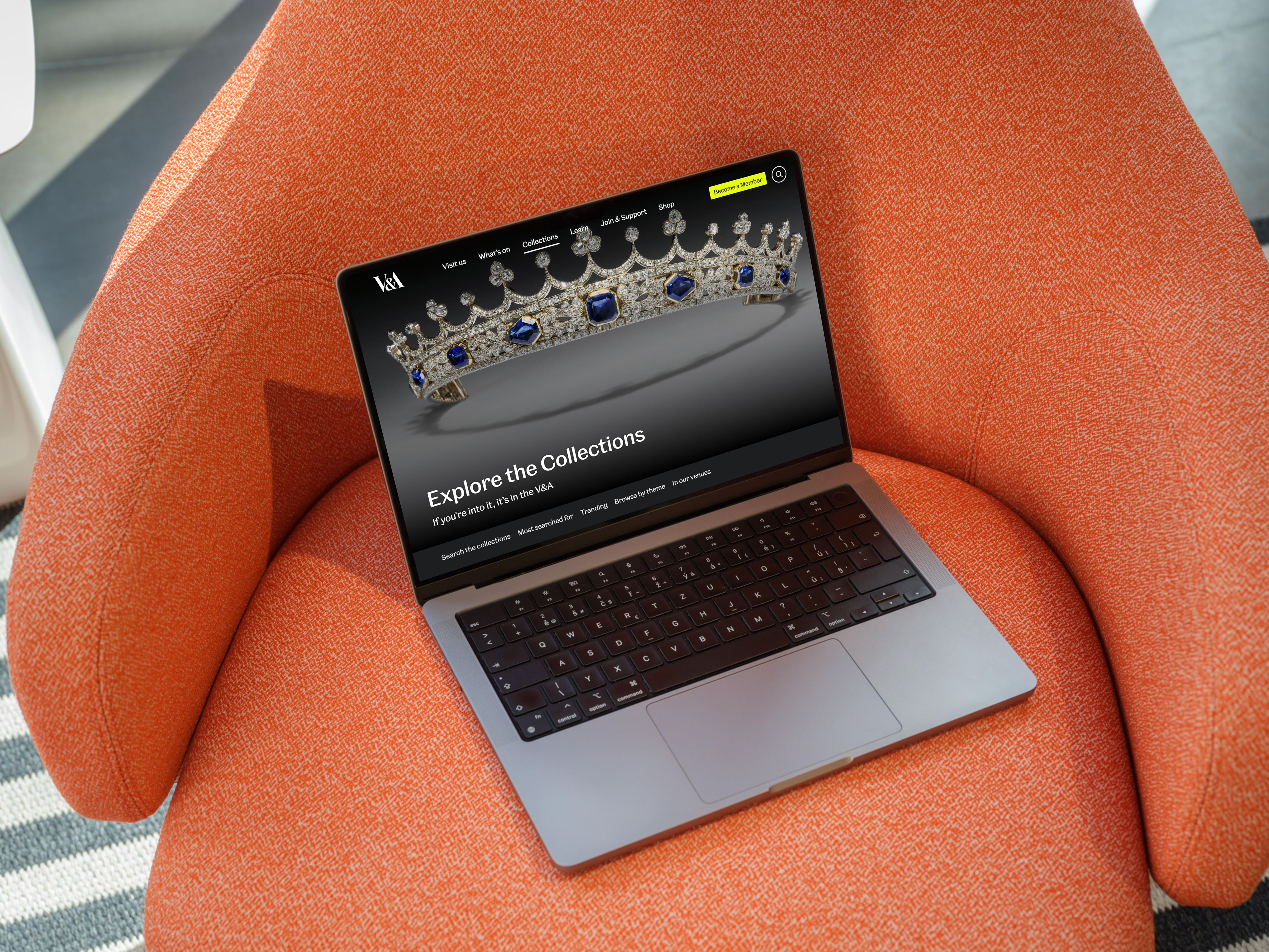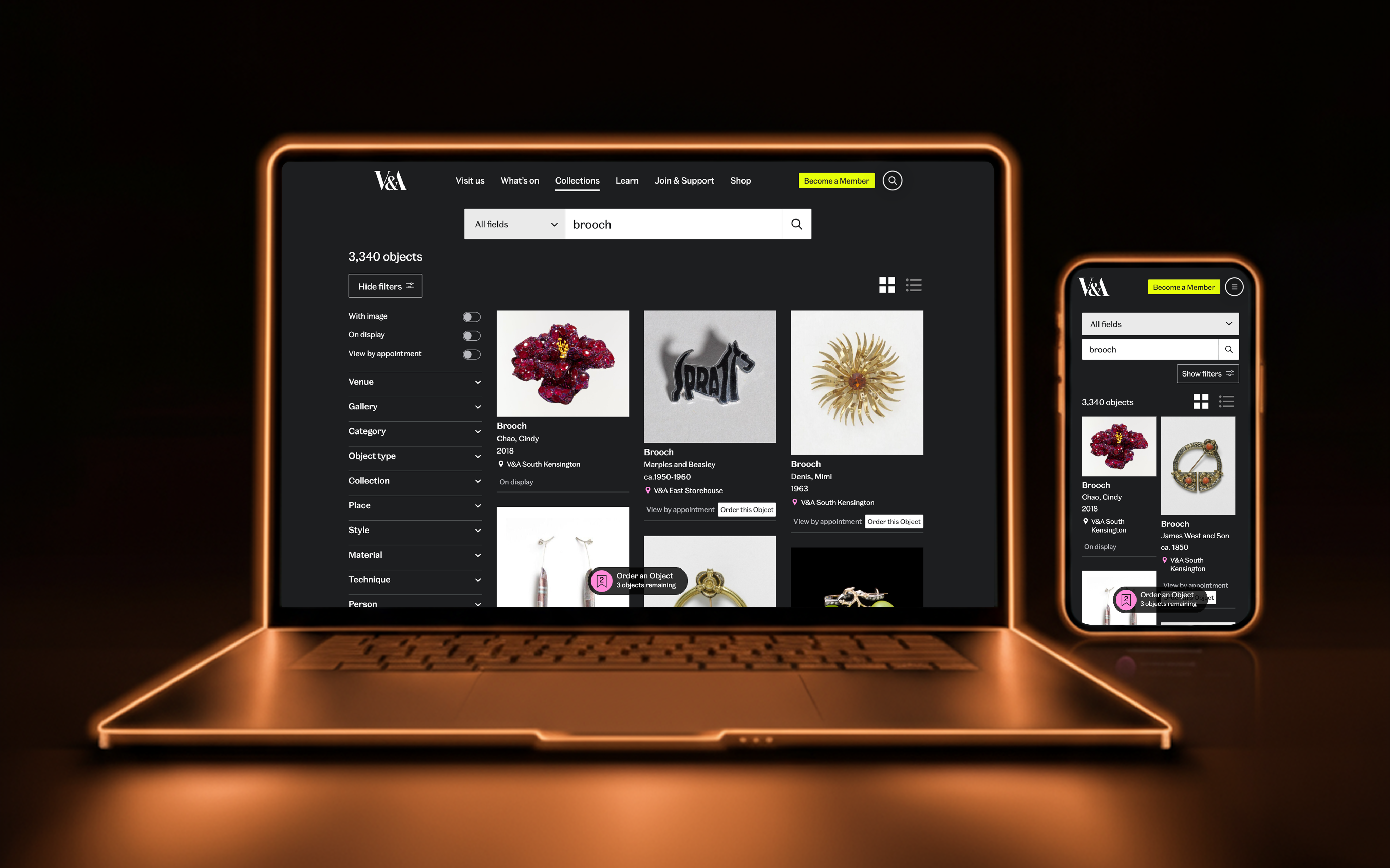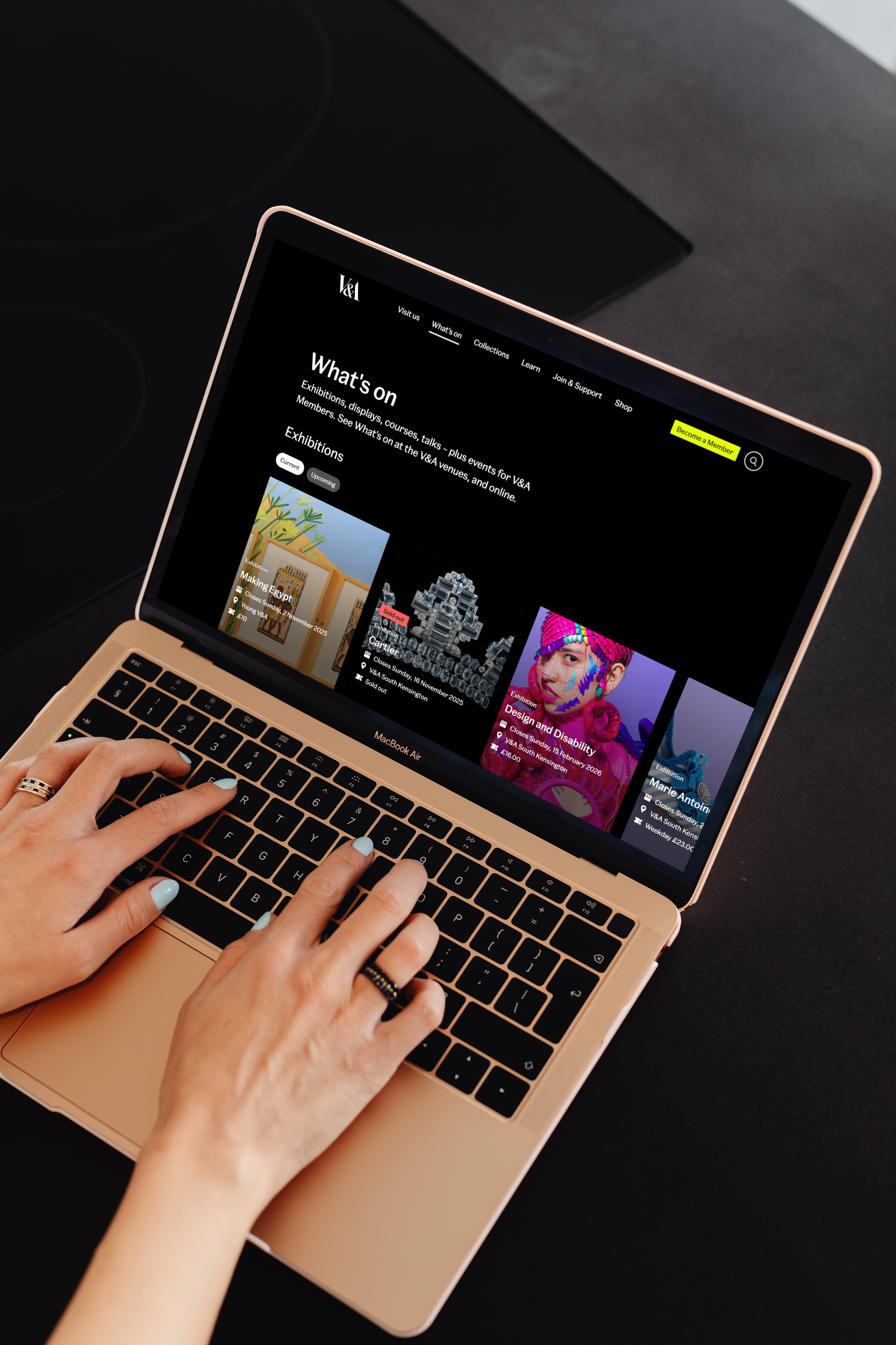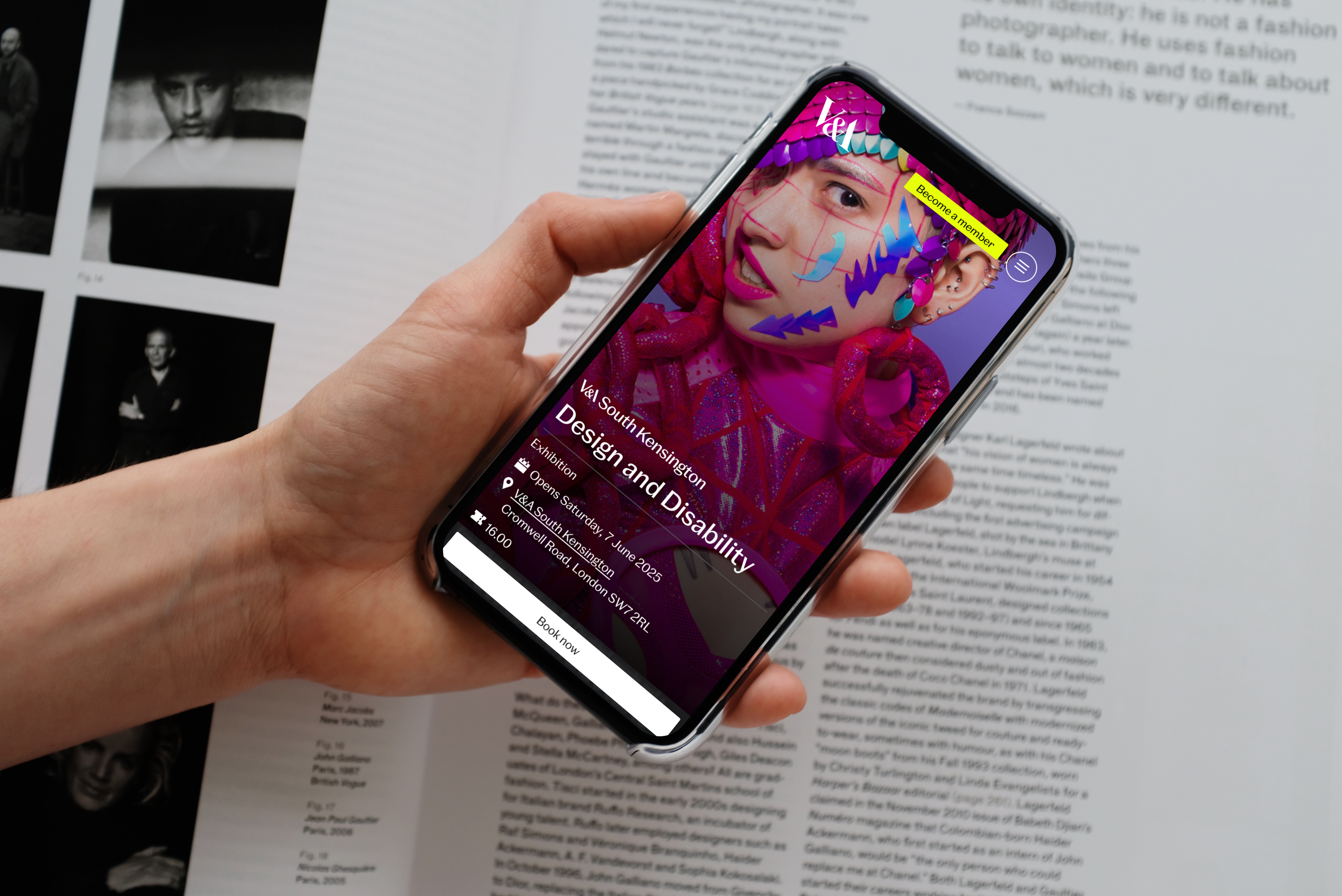
Exhibition Page
Context
The V&A runs numerous exhibitions across its venues, but the existing Exhibition Page primarily prioritised ticket sales. Memberships, a key commercial goal for the museum, were treated as secondary, and the experience was not optimised for mobile, despite the majority of visitors browsing via phones.
The redesign of the Exhibition Page aimed to rebalance priorities, promoting memberships alongside ticket sales, improving mobile usability, and boosting newsletter sign-ups throughout the exhibition lifecycle.
Design completed. Not yet deployed.
Overview
Role
Product Designer (End to end UI/UX)
Company
V&A Museum
Duration
3 months
Team
1 Product Manager; 1 Product Designer (me); 2 Developers; Multiple Stakeholders
Problem
Research and stakeholder feedback revealed key pain points that limited commercial and user experience potential.
Ticket-first hierarchy
01
The design heavily prioritised ticketing, leaving membership and newsletter CTAs hidden.
Mobile experience
02
Navigation and CTA access were limited on small screens, despite being the main user platform.
Lifecycle consistency
03
Messaging was not aligned across exhibition phases, leading to missed conversion opportunities.
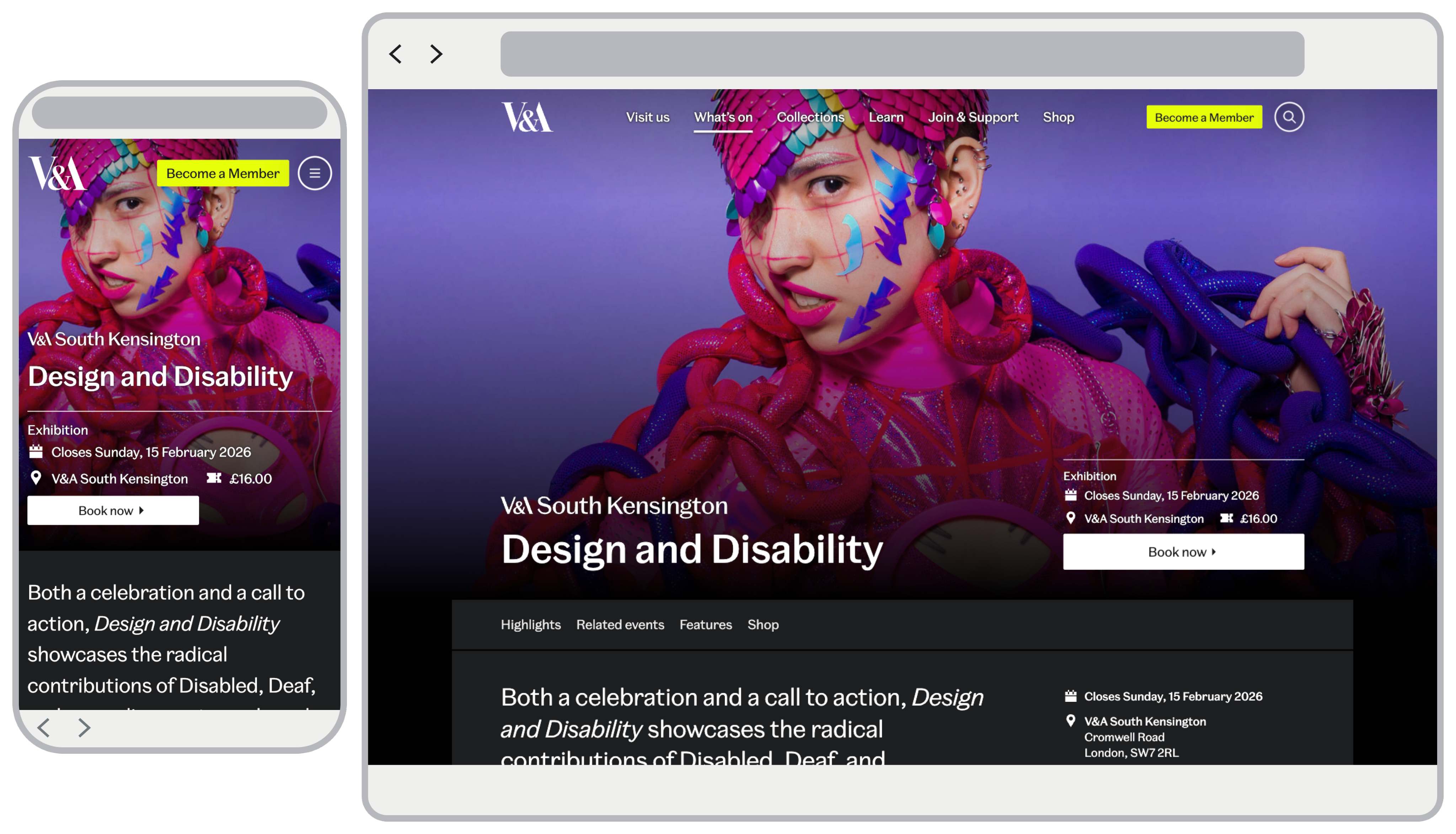
Previous design
Process
Wireframing and Exploration
I mapped the full exhibition lifecycle, from announcement to post-opening, to identify key conversion moments. The wireframes explored how the template could adapt its messaging across membership, ticketing, and sign-ups.
The process focused on four main areas:
- Sticky CTA: a primary button that adapts by phase and ticket availability.
- Header & info panel: merged duplicated content into a single unified header component.
- Newsletter and waitlist: one flexible sign-up form, acting as a newsletter pre-launch and a waitlist post-sellout.
- Phase-specific layouts: tailored designs for each exhibition phase to keep visuals consistent and messaging relevant.
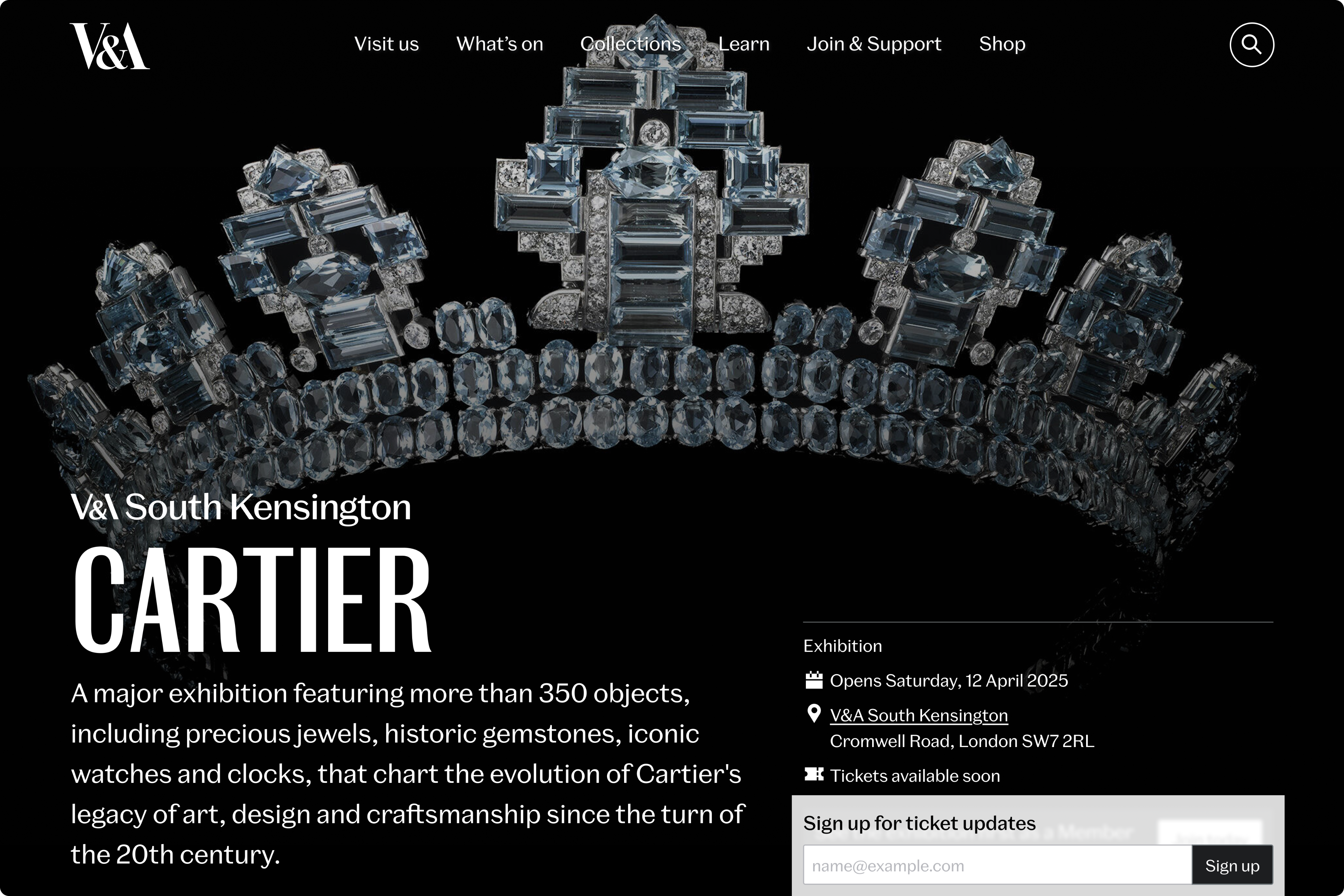
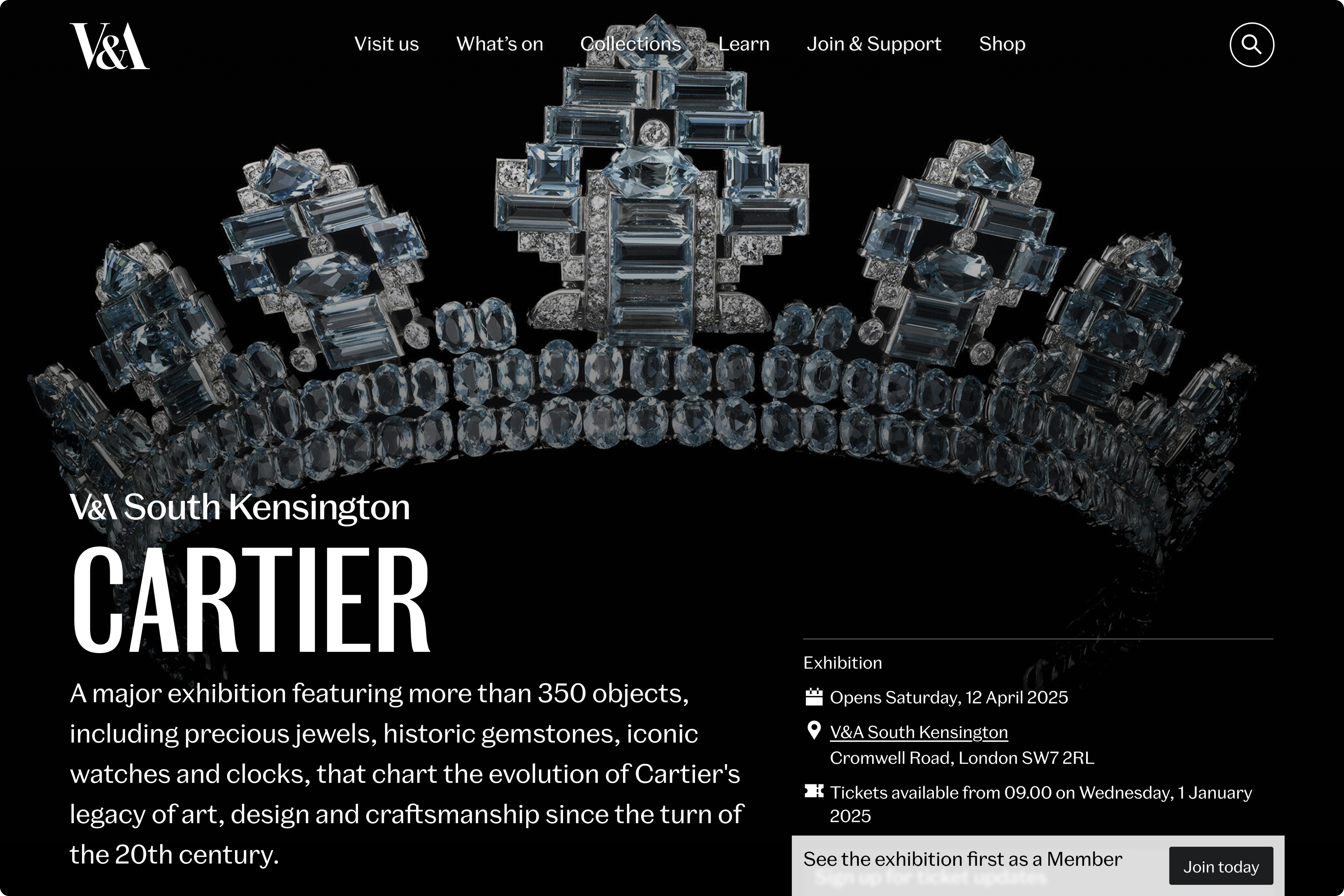
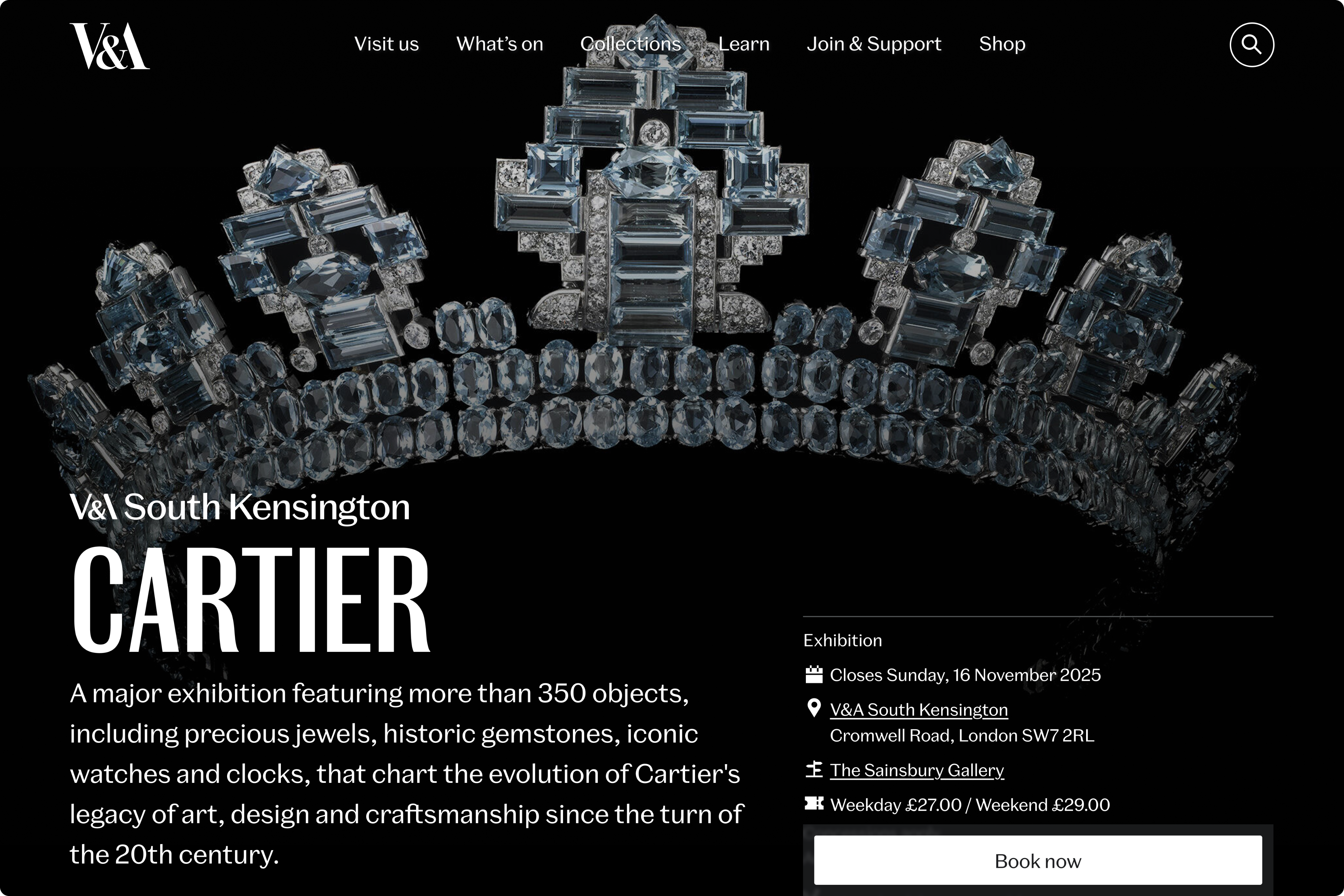
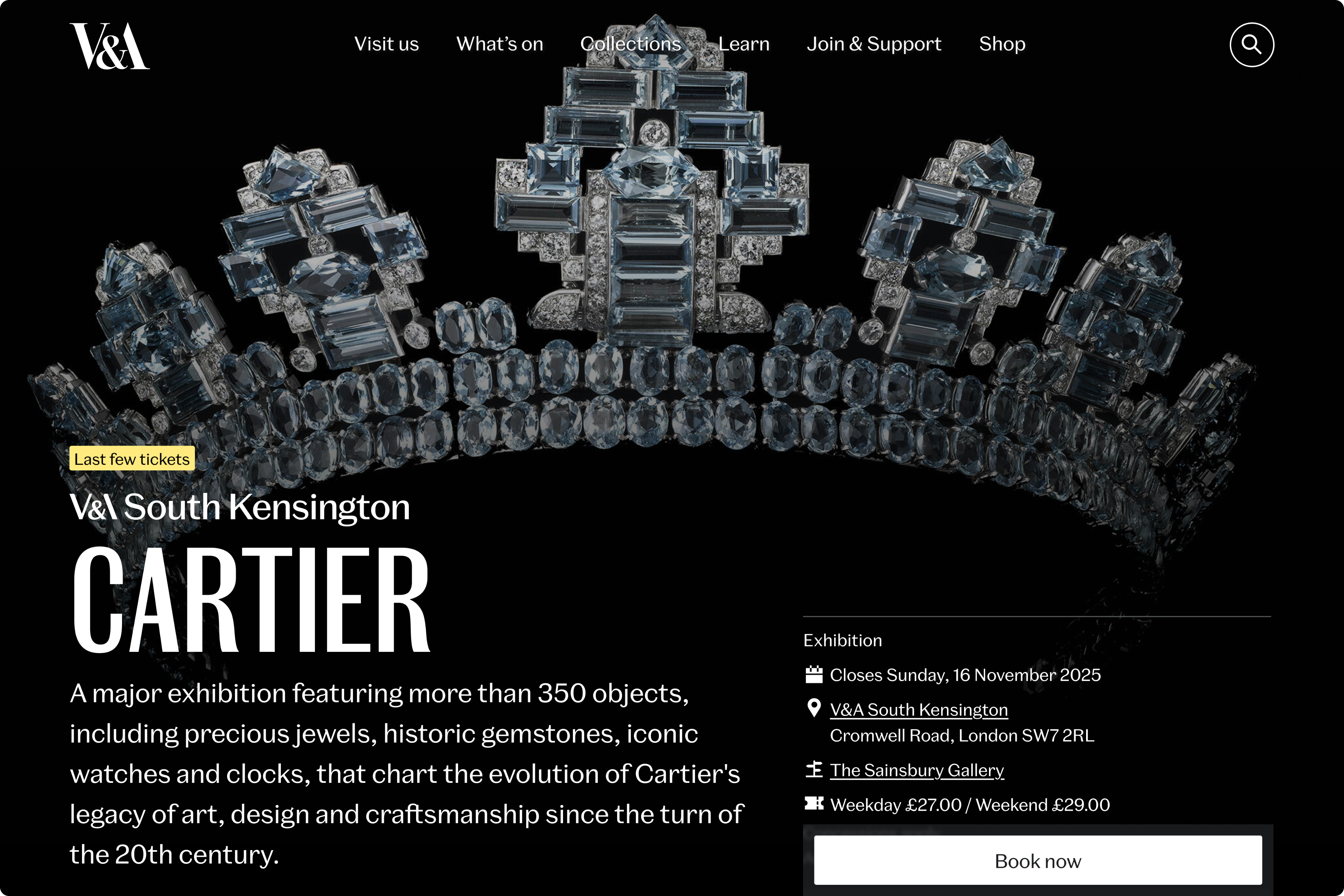
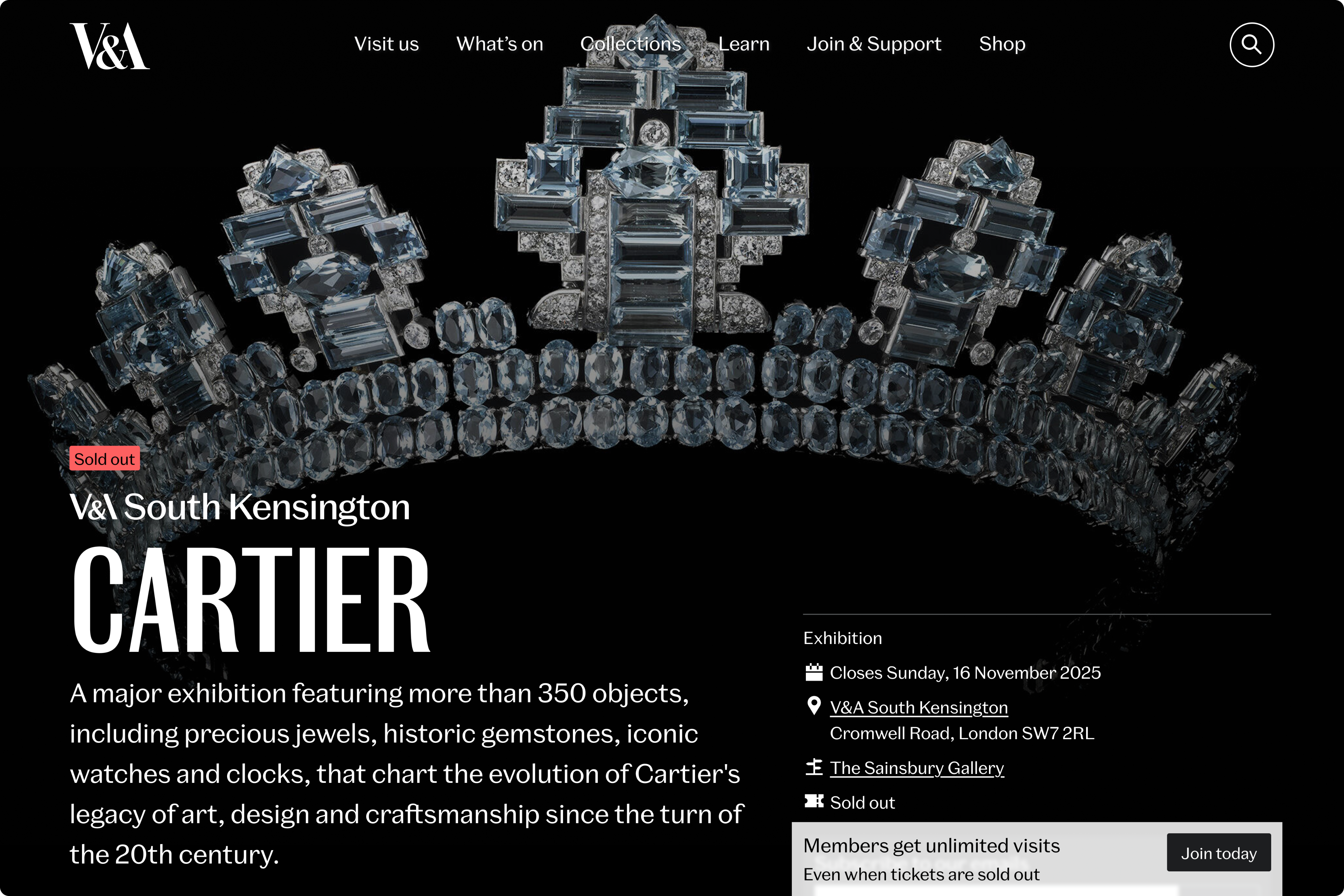
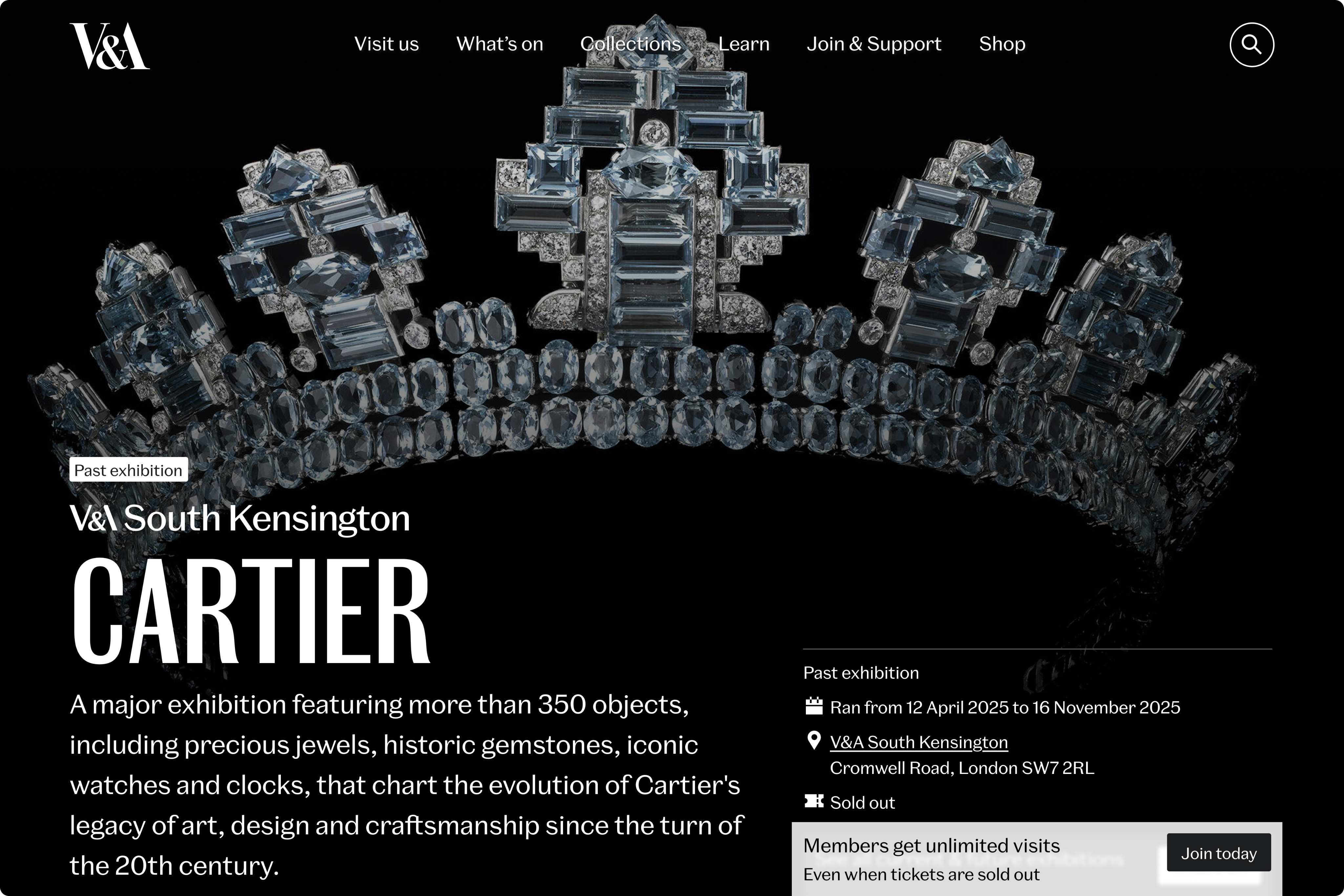
Prototyping
Once the wireframes were validated, I developed high-fidelity prototypes to demonstrate how the template dynamically adapted content and hierarchy across lifecycle stages.
- Announcement: focused on early engagement through newsletter sign-ups and membership awareness.
- Tickets on sale date announced: introduced anticipation messaging while maintaining membership visibility.
- Tickets on sale: switched the primary CTA to ‘Book Tickets’, with membership as the secondary prompt.
- Open to Public: maintained ticketing priority while reinforcing membership benefits.
- Sold Out: replaced ticket CTAs with membership and waitlist options to sustain engagement post-sellout.
User testing
Our UXR conducted unmoderated usability testing with 10 participants (a mix of culturally engaged visitors from the UK and USA). The group included users with a range of interests in art and design, and three participants with accessibility needs, ensuring the study reflected a diverse and inclusive audience. These were the key findings:
Clear exhibition understanding
01
Users easily identified exhibition details like theme, location, and cost.
Unclear membership value
02
Membership prompts were noticed, but benefits and pricing were unclear.
Newsletter uncertainty
03
Users saw sign-up forms but didn’t know what updates they’d receive.
Effective availability cues
04
Colour-coded labels (Last Few Tickets, Sold Out) were quickly recognised and understood.
Membership interest after sellout
05
Seeing ‘Sold Out’ prompted users to explore membership as an alternative.
Final design
Delivered high-fidelity prototypes in Figma for stakeholder review and developer handoff.The new design introduced:
- Mobile-first design improving UX and conversion.
- Sticky CTA for continuous conversion access of membership, tickets and sign-ups.
- Lifecycle-adaptive templates for each exhibition phase.
- Integrated newsletter and waitlist forms for ongoing engagement.
Accessible, responsive layouts optimised for performance and clarity.
Design completed. Not yet deployed.
Outcome and impact
Quantitative performance metrics are not yet available, as the rollout is scheduled for late 2025, but stakeholder feedback and early qualitative results indicate a significant improvement in clarity and conversion intent. These are some of the expected results:
Higher conversion
Enhanced visibility for membership will lead into higher conversions.
Improved mobile UX
Mobile-first approach improves mobile usability and conversion accessibility.
Clear communication
Streamlined communication through every exhibition phase.

Exhibition Page
Context
The V&A runs numerous exhibitions across its venues, but the existing Exhibition Page primarily prioritised ticket sales. Memberships, a key commercial goal for the museum, were treated as secondary, and the experience was not optimised for mobile, despite the majority of visitors browsing via phones.
The redesign of the Exhibition Page aimed to rebalance priorities, promoting memberships alongside ticket sales, improving mobile usability, and boosting newsletter sign-ups throughout the exhibition lifecycle.
Design completed. Not yet deployed.
Overview
Role
Product Designer (End to end UI/UX)
Company
V&A Museum
Duration
3 months
Team
1 Product Manager; 1 Product Designer (me); 2 Developers; Multiple Stakeholders
Problem
Research and stakeholder feedback revealed key pain points that limited commercial and user experience potential.
Ticket-first hierarchy
01
The design heavily prioritised ticketing, leaving membership and newsletter CTAs hidden.
Mobile experience
02
Navigation and CTA access were limited on small screens, despite being the main user platform.
Lifecycle consistency
03
Messaging was not aligned across exhibition phases, leading to missed conversion opportunities.

Previous design
Process
Wireframing and Exploration
I mapped the full exhibition lifecycle, from announcement to post-opening, to identify key conversion moments. The wireframes explored how the template could adapt its messaging across membership, ticketing, and sign-ups.
The process focused on four main areas:
- Sticky CTA: a primary button that adapts by phase and ticket availability.
- Header & info panel: merged duplicated content into a single unified header component.
- Newsletter and waitlist: one flexible sign-up form, acting as a newsletter pre-launch and a waitlist post-sellout.
- Phase-specific layouts: tailored designs for each exhibition phase to keep visuals consistent and messaging relevant.






Prototyping
Once the wireframes were validated, I developed high-fidelity prototypes to demonstrate how the template dynamically adapted content and hierarchy across lifecycle stages.
- Announcement: focused on early engagement through newsletter sign-ups and membership awareness.
- Tickets on sale date announced: introduced anticipation messaging while maintaining membership visibility.
- Tickets on sale: switched the primary CTA to ‘Book Tickets’, with membership as the secondary prompt.
- Open to Public: maintained ticketing priority while reinforcing membership benefits.
- Sold Out: replaced ticket CTAs with membership and waitlist options to sustain engagement post-sellout.
User testing
Our UXR conducted unmoderated usability testing with 10 participants (a mix of culturally engaged visitors from the UK and USA). The group included users with a range of interests in art and design, and three participants with accessibility needs, ensuring the study reflected a diverse and inclusive audience. These were the key findings:
Clear exhibition understanding
01
Users easily identified exhibition details like theme, location, and cost.
Unclear membership value
02
Membership prompts were noticed, but benefits and pricing were unclear.
Newsletter uncertainty
03
Users saw sign-up forms but didn’t know what updates they’d receive.
Effective availability cues
04
Colour-coded labels (Last Few Tickets, Sold Out) were quickly recognised and understood.
Membership interest after sellout
05
Seeing ‘Sold Out’ prompted users to explore membership as an alternative.
Final design
Delivered high-fidelity prototypes in Figma for stakeholder review and developer handoff.The new design introduced:
- Mobile-first design improving UX and conversion.
- Sticky CTA for continuous conversion access of membership, tickets and sign-ups.
- Lifecycle-adaptive templates for each exhibition phase.
- Integrated newsletter and waitlist forms for ongoing engagement.
Accessible, responsive layouts optimised for performance and clarity.
Design completed. Not yet deployed.
Outcome and impact
Quantitative performance metrics are not yet available, as the rollout is scheduled for late 2025, but stakeholder feedback and early qualitative results indicate a significant improvement in clarity and conversion intent. These are some of the expected results:
Higher conversion
Enhanced visibility for membership will lead into higher conversions.
Improved mobile UX
Mobile-first approach improves mobile usability and conversion accessibility.
Clear communication
Streamlined communication through every exhibition phase.

Exhibition Page
Context
The V&A runs numerous exhibitions across its venues, but the existing Exhibition Page primarily prioritised ticket sales. Memberships, a key commercial goal for the museum, were treated as secondary, and the experience was not optimised for mobile, despite the majority of visitors browsing via phones.
The redesign of the Exhibition Page aimed to rebalance priorities, promoting memberships alongside ticket sales, improving mobile usability, and boosting newsletter sign-ups throughout the exhibition lifecycle.
Design completed. Not yet deployed.
Overview
Role
Product Designer (End to end UI/UX)
Company
V&A Museum
Duration
3 months
Team
1 Product Manager; 1 Product Designer (me); 2 Developers; Multiple Stakeholders
Problem
Research and stakeholder feedback revealed key pain points that limited commercial and user experience potential.
Ticket-first hierarchy
01
The design heavily prioritised ticketing, leaving membership and newsletter CTAs hidden.
Mobile experience
02
Navigation and CTA access were limited on small screens, despite being the main user platform.
Lifecycle consistency
03
Messaging was not aligned across exhibition phases, leading to missed conversion opportunities.

Previous design
Process
Wireframing and Exploration
I mapped the full exhibition lifecycle, from announcement to post-opening, to identify key conversion moments. The wireframes explored how the template could adapt its messaging across membership, ticketing, and sign-ups.
The process focused on four main areas:
- Sticky CTA: a primary button that adapts by phase and ticket availability.
- Header & info panel: merged duplicated content into a single unified header component.
- Newsletter and waitlist: one flexible sign-up form, acting as a newsletter pre-launch and a waitlist post-sellout.
- Phase-specific layouts: tailored designs for each exhibition phase to keep visuals consistent and messaging relevant.






Prototyping
Once the wireframes were validated, I developed high-fidelity prototypes to demonstrate how the template dynamically adapted content and hierarchy across lifecycle stages.
- Announcement: focused on early engagement through newsletter sign-ups and membership awareness.
- Tickets on sale date announced: introduced anticipation messaging while maintaining membership visibility.
- Tickets on sale: switched the primary CTA to ‘Book Tickets’, with membership as the secondary prompt.
- Open to Public: maintained ticketing priority while reinforcing membership benefits.
- Sold Out: replaced ticket CTAs with membership and waitlist options to sustain engagement post-sellout.
User testing
Our UXR conducted unmoderated usability testing with 10 participants (a mix of culturally engaged visitors from the UK and USA). The group included users with a range of interests in art and design, and three participants with accessibility needs, ensuring the study reflected a diverse and inclusive audience. These were the key findings:
Clear exhibition understanding
01
Users easily identified exhibition details like theme, location, and cost.
Unclear membership value
02
Membership prompts were noticed, but benefits and pricing were unclear.
Newsletter uncertainty
03
Users saw sign-up forms but didn’t know what updates they’d receive.
Effective availability cues
04
Colour-coded labels (Last Few Tickets, Sold Out) were quickly recognised and understood.
Membership interest after sellout
05
Seeing ‘Sold Out’ prompted users to explore membership as an alternative.
Final design
Delivered high-fidelity prototypes in Figma for stakeholder review and developer handoff.The new design introduced:
- Mobile-first design improving UX and conversion.
- Sticky CTA for continuous conversion access of membership, tickets and sign-ups.
- Lifecycle-adaptive templates for each exhibition phase.
- Integrated newsletter and waitlist forms for ongoing engagement.
Accessible, responsive layouts optimised for performance and clarity.
Design completed. Not yet deployed.
Outcome and impact
Quantitative performance metrics are not yet available, as the rollout is scheduled for late 2025, but stakeholder feedback and early qualitative results indicate a significant improvement in clarity and conversion intent. These are some of the expected results:
Higher conversion
Enhanced visibility for membership will lead into higher conversions.
Improved mobile UX
Mobile-first approach improves mobile usability and conversion accessibility.
Clear communication
Streamlined communication through every exhibition phase.
Other projects
